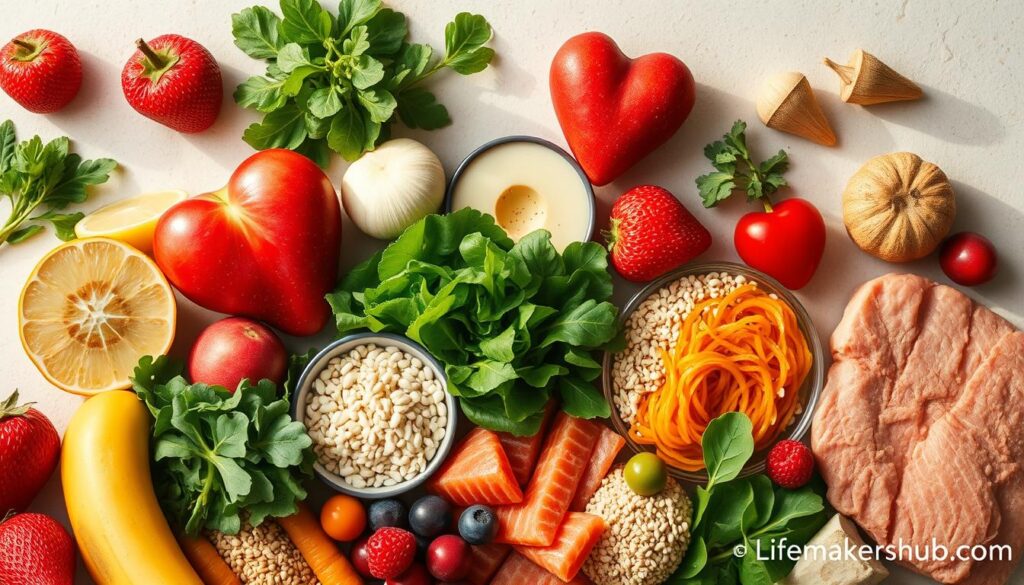Nutrition Advice to Boost Your Wellbeing
Nutrition advice can seem too much, but science offers clear ways to get healthier. Focus on increasing fiber, calcium, vitamin D, and potassium. These are nutrients most Americans don’t get enough of.
Try to cut down on sodium by eating more fresh foods. This is because 70% of Americans’ salt comes from packaged items like bread and pizza. Also, limit added sugars, which are linked to obesity and diabetes. Stick to whole foods like fruits, vegetables, and fortified options like soy beverages or whole-grain cereals.
Healthy eating tips begin with balance. Eat colorful veggies, lean proteins like fish twice a week, and drink plenty of water. Follow guidelines for 2,000–2,500 daily calories and 5 portions of fruits/veggies daily. Avoid ultra-processed foods to lower disease risks.
Small changes, like swapping sugary drinks for water, can make a big difference. Evidence shows that mindful habits, like tracking what you eat and exercising weekly, support long-term health.
Key Takeaways
- Increase fiber, calcium, vitamin D, and potassium intake.
- Limit sodium by choosing less packaged foods—90% of American sodium comes from salt.
- Replace sugary drinks with water to cut added sugar risks like heart disease.
- Incorporate fish, nuts, and seeds for heart health and longevity.
- Maintain balanced meals with colorful produce and lean proteins.
Understanding the Basics of Nutrition
Learning about nutrition begins with understanding the importance of balance. Your body needs three main nutrients: carbohydrates, protein, and fat. Each one has its own role in keeping you healthy and active.
“The key to a healthy diet is to eat the right amount of calories for how active you are so you balance the energy you consume with the energy you use.”
Macronutrients Explained
- Carbohydrates: Give you quick energy. Choose whole grains like brown rice and quinoa over white bread.
- Protein: Helps build and repair tissues. Eat more plant-based proteins like beans and lean meats like fish twice a week.
- Fat: Important for hormone production. Pick unsaturated fats from avocados and nuts over saturated fats in fried foods.
Getting personalized nutrition advice can help. For instance, athletes might need more carbs, while older adults might focus on protein to keep muscles strong. The Healthy Eating Plate model, updated in 2023, suggests:
- Fill 50% of your plate with vegetables and fruits (excluding starchy potatoes).
- Use 25% for whole grains.
- Use 25% for healthy proteins like tofu or poultry.
Stay away from ultra-processed foods, which are common in Canadian diets. Instead, choose homemade meals to cut down on added sugars. Following these guidelines with mindful hydration and expert advice ensures your diet meets your specific needs.
Understanding the Basics of Nutrition
Macronutrients give you energy, but micronutrients are just as important. Vitamins and minerals, even in small amounts, help your body build bones and fight off sickness. The U.S. dietary guidelines say most people don’t get enough fiber, calcium, vitamin D, and potassium.
Not getting enough of these can make your bones weak, mess with your metabolism, and raise the risk of chronic diseases.
- Calcium & vitamin D: Found in dairy, fortified plant-based milk, and fatty fish. Together, they build strong bones.
- Potassium: Bananas, spinach, and sweet potatoes help balance fluids and nerve function.
- Fiber: Whole grains, legumes, and berries support digestion and heart health.
Fat-soluble vitamins (A, D, E, K) are stored in your body. Water-soluble vitamins (B and C) need daily intake from fruits, veggies, and grains. Too much sodium and added sugars in processed foods can harm your health.
“A registered dietitian can provide individualized dietary advice to address personal deficiencies,” advises the Academy of Nutrition and Dietetics. Their 2020-2025 guidelines recommend prioritizing whole foods over processed items to meet micronutrient needs.
Supplements like vitamin D or iron might be needed if you’re not getting enough from food. But try changing your diet first. A nutrition consultant can help create a plan that fits your health goals. Eating nutrient-rich foods helps avoid deficiencies and keeps your body running well.
Understanding the Basics of Nutrition
Hydration is more than just drinking water to quench thirst. It’s a key part of nutrition advice and wellness recommendations. Your body uses water to keep its temperature right, move nutrients, and get rid of waste. Even a little dehydration can make you feel slow and tired.
“Hydration is an important and often overlooked marker of health. Staying hydrated helps ensure that your body is functioning optimally and that your blood volume is sufficient.”
Adults should drink 8–10 cups of water a day. But, if you’re active or it’s hot outside, you might need more. Keep a refillable bottle with you and set reminders to drink. Water is the best choice because it has no calories and no additives.
Herbal teas or diluted fruit juices can also help. But, avoid sugary drinks and too much caffeine. They can make dehydration worse.
- Infuse water with lemon, cucumber, or mint for flavor.
- Monitor urine color—pale yellow means proper hydration.
- Include hydratinging foods like watermelon, celery, or yogurt.
Dehydration signs include headaches, feeling dizzy, or dry skin. Pay attention to how your body feels and drink more if needed. Drinking enough water helps all parts of your body, from your kidneys to your skin. Make it a big part of your daily routine.
The Role of a Balanced Diet
Building a balanced plate is easy with balanced diet suggestions that focus on variety and portion control. Picture your plate divided into sections. Half should be vegetables and fruits, a quarter for whole grains, and the last quarter for lean proteins. This way, you get all the nutrients you need without eating too much.
- Vegetables and fruits (50%): Choose colorful options like leafy greens, berries, and carrots for fiber and phytonutrients.
- Whole grains (25%): Opt for brown rice, quinoa, or whole-wheat bread for sustained energy.
- Proteins (25%: Include fish, beans, tofu, or chicken to support muscle and tissue health.
The “eat the rainbow” principle is a great healthy eating tip. It encourages you to eat a variety of colors. Orange vegetables like sweet potatoes give you vitamin A. Leafy greens like spinach offer iron. Add healthy fats like avocado or nuts, and cut down on sugary drinks.
Guides like Harvard’s Healthy Eating Plate suggest adding water-rich foods like cucumbers and soups. Stay away from processed meats and refined carbs. Instead, choose minimally processed ingredients. Even small changes, like swapping white rice for farro or adding a salad to lunch, can help. By making these balanced diet suggestions your own, you build habits that are good for your body and the planet.
The Role of a Balanced Diet
Portion control isn’t about cutting back—it’s about finding balance. diet guidelines suggest eating the right amount of calories for your activity level. Here’s how to get portions right without counting every bite:
“The key to a healthy diet is to eat the right amount of calories for how active you are,” says the USDA.
- Use Visual Cues
A fist = veggies/fruits. A palm = protein. A thumb = fats. These hand measurements make portion tracking easy. - Follow Plate Proportions
Fill half your plate with veggies, a quarter with grains, and a quarter with protein. This follows USDA’s diet guidelines for balanced meals. - Mind Your Meals
Eat slowly and enjoy each bite. This mindful eating helps you know when you’re full and avoid overeating. - Adjust for Activity
If you’re active, you might need bigger portions of foods like whole grains and legumes.
| Food Group | Portion Size | Examples |
|---|---|---|
| Vegetables | 1 cup raw | Broccoli, spinach, carrots |
| Protein | 3-4 oz cooked | Chicken breast, tofu, beans |
| Grains | ½ cup cooked | Quinoa, brown rice, oats |
| Fruits | 1 medium fruit or ½ cup dried | Apple, berries, raisins |
Get help from a nutrition consulting expert to adjust portions for your goals. Even small changes in portion sizes can make a big difference in your health—without the need for strict calorie counting.
Special Dietary Needs and Considerations
Adults should do at least 150 minutes of moderate exercise each week, says the Physical Activity Guidelines for Americans. Athletes need more because they are more active. Getting the right dietary advice is key for top performance and recovery.
Nutrition for Athletes
Training hard increases your calorie needs by 20–30%. You should eat 1.2–2.0 grams of protein per kg of body weight every day to build muscle. Carbs are important for energy; eat 1–4g per kg of body weight before and after working out.
Drinking enough water is also crucial, especially during long activities. You need to replace lost electrolytes.
- Pre-Workout: Eat a carb-rich meal 3 hours before activity.
- Post-Workout: Combine protein and carbs within 30 minutes to enhance recovery.
- Hydration: Drink water or electrolyte drinks during long sessions.
Adjust your diet to match your training phases. Endurance athletes, for example, need more carbs during peak training. Make sure you don’t have relative energy deficiency in sport (RED-S) by eating enough calories.
See a registered dietitian for a plan that fits your needs. They can help with the right amount of macros, timing, and recovery. A personalized plan helps avoid deficiencies and boosts your performance.
Special Dietary Needs and Considerations
Nutrition advice for seniors focuses on adapting to aging bodies. A balanced diet suggestions must address reduced metabolism, muscle maintenance, and chronic disease prevention. Start by prioritizing protein-rich foods like lean meats, beans, and Greek yogurt to combat muscle loss.
- Key Nutrients: Aim for 1,200–1,300 mg of calcium daily through dairy or fortified plant-based milk. Pair with vitamin D (600–800 IU) via sunlight or supplements for bone strength.
- Vitamin B12 needs increase due to age-related absorption issues—fortified cereals or B12 shots may be necessary.
- Include fiber-rich foods like oats and berries to support digestion and heart health.
Staying active enhances nutrition benefits. Pair meals with 150 minutes weekly of walking or swimming, plus twice-weekly strength training. The MyPlate Plan helps seniors visualize portions: fill half your plate with colorful veggies and fruits, and choose whole grains.
- Safety Tips: Follow WHO’s Clean-Separate-Cook-Chill guidelines to avoid foodborne illness.
- Limit sodium to under 5g daily to reduce hypertension risks. Opt for herbs instead of salt when seasoning.
- Stay hydrated by sipping water hourly—even if you don’t feel thirsty.
Enjoy meals with friends or community groups to boost enjoyment and adherence to healthy eating. Always consult a healthcare provider before starting new supplements. Small adjustments today mean better energy and independence tomorrow.
Meal Planning Made Simple
Effective meal planning strategies can turn chaos into routine. Begin by setting aside 30 minutes each week to plan meals. Think about your dietary needs and how much time you have. Preparing ingredients ahead of time can make cooking easier. Here’s how to set up a system that fits your life:
- Choose 3-4 main proteins for the week (chicken, fish, tofu).
- Batch-cook grains like quinoa or brown rice in advance.
- Prep veggies by washing, chopping, and storing in airtight containers.
Storing food right keeps it fresh. Check out this guide for the best ways to store food:
| Food Type | Refrigerator Storage | Freezer Storage |
|---|---|---|
| Cooked Ground Meat | 1-2 days | 3-6 months |
| Beans | 5 days | 2-3 months |
| Hard Cheese | 6-8 weeks (opened) | 6 months |
| Vegetables | 3-5 days | 8-12 months (blanched) |
eMeals makes meal planning strategies easier with 15 customizable plans. Subscribers can save up to $2,000 a year by cutting down on takeout. Their app works with Walmart and Instacart for easy grocery lists. Try their 14-day free trial to see options like “Meatless Mondays” or “Whole30-friendly” menus.
“Meal prep reduces decision fatigue by 40% when using a structured plan.”
Combine this system with nutrition consulting for personal touches. Begin with planning just 3 meals a week. Then, grow your strategy as you get more comfortable. Small steps lead to lasting habits that fit your lifestyle.
Meal Planning Made Simple
Creating a grocery list for healthy eating starts with a plan. Wellness tips suggest picking foods rich in nutrients for your meals. Follow these steps to make shopping easier and align your list with your diet goals.
Creating a Balanced Grocery List
Organize your list by food groups for variety and nutrition:
| Food Group | Examples |
|---|---|
| Fruits | Apples, berries, citrus |
| Vegetables | Leafy greens, broccoli, carrots |
| Protein | Chicken breast, lentils, tofu |
| Grains | Quinoa, brown rice, oats |
| Dairy/Alternatives | Greek yogurt, almond milk |
- Start with the store perimeter for fresh produce and proteins.
- Choose seasonal fruits/veggies to save money and ensure freshness.
- Compare unit prices on pantry staples like canned beans or whole-grain pasta.
Use the USDA’s MyPlate guidelines: half your plate should be fruits and vegetables. Opt for whole-grain starches and lean proteins in smaller portions.
Pro Tip:Read labels to avoid added sugars and sodium. Look for items with
Stick to your list! Stores place impulse items at checkout—avoid buying snacks not on your plan. A well-structured list turns grocery shopping into a tool for long-term wellness recommendations.
The Impact of Nutrition on Mental Health

Most people think nutrition is just for the body, but it’s also key for your mind. Studies show that 13% of the world’s population deals with mental health issues. Eating the right foods can help you feel better and think clearer.
Foods That Boost Mood
Some nutrients are especially good for your brain. Here are some foods that can help:
- Fatty fish (salmon, mackerel) have omega-3s that fight inflammation and help your brain work better.
- Nuts and seeds are full of zinc and magnesium, which help keep your mood steady.
- Leafy greens (spinach, kale) have folate, a B vitamin that can lower your risk of depression.
- Fermented foods (yogurt, sauerkraut) are good for your gut, which is connected to your brain.
Stay away from junk snacks and sugary drinks. They can make you feel jittery and irritable. Too much caffeine or alcohol can make anxiety worse, so drink in moderation.
- Eat oily fish like salmon twice a week, as diet guidelines suggest.
- Add nuts or seeds to your meals for a steady energy boost.
- Drink water instead of soda to stay sharp and hydrated.
Even small changes can make a big difference. Eating foods rich in nutrients can help your mind and body. Start with one simple change today.
The Impact of Nutrition on Mental Health
Your brain needs specific nutrients to stay sharp. Research shows two-thirds of adults know this, but many don’t know what foods to choose. The MIND diet combines Mediterranean and DASH principles to protect brain health.
A 2022 study found this diet reduced depression symptoms by 20 points on average. This is three times more than without any intervention.
- Omega-3 fatty acids (fish, walnuts) build brain cell membranes
- Vitamin B12 (fortified cereals) slows cognitive decline
- Choline (eggs, soy) boosts memory pathways
| Nutrient | Best Sources | Key Role |
|---|---|---|
| Vitamin E | Almonds, spinach | Slows oxidative damage |
| Flavonoids | Blueberries, dark chocolate | Enhances blood flow |
Blood sugar swings can make it hard to focus. Low-carb diets may lower serotonin, affecting mood over time. Pairing nutritional counseling with meal planning strategies ensures you balance these nutrients daily.
For example, the Mediterranean diet lowers inflammation linked to anxiety.
Supplements like vitamin D and probiotics (Bifidobacterium longum) show promise. A 2022 trial found 14 out of 22 IBS patients saw improved mood with probiotic use. Start small: swap processed snacks for nuts and berries. Your brain deserves fuel that keeps it sharp today and protects it for tomorrow.
Common Dietary Myths Debunked
Many Americans are confused by nutrition trends. One big myth is that everyone needs a gluten-free diet. Let’s sort out what’s true and what’s not.
Gluten-Free Diets: Fact vs. Fiction
Gluten is a protein found in wheat, barley, and rye. It’s a big problem for those with celiac disease or sensitivities. Not everyone needs to avoid it. Cutting gluten without a reason can lead to missing out on important nutrients.
“Gluten-free isn’t a one-size-fits-all solution. It’s critical for those with medical needs, but others may lose key nutrients like fiber and B vitamins,” says Dr. Emily Chen, a registered dietitian.
- Myth: Gluten-free foods are automatically healthier.
- Fact: Many products replace gluten with added sugars or fats, undermining dietary advice.
- Myth: Cutting gluten boosts energy or weight loss.
- Fact: Weight loss often stems from calorie reduction, not gluten itself.
Not cutting gluten can mess up a balanced diet. Whole grains like oats and barley are full of fiber and iron. For most, foods with gluten can be part of a healthy diet if chosen carefully.
Always follow advice from experts. If you’re still unsure, see a doctor for tests. For others, focus on eating whole foods—gluten-free or not—to build a balanced diet that suits you.
Common Dietary Myths Debunked
Low-carb diets get a lot of attention, but the truth is more complex. It’s important to know the facts to make choices that are good for your health.
Low-Carb Diets: What to Know
Carbs aren’t bad for you. Refined carbs like sugary snacks and white bread are missing fiber and nutrients. On the other hand, complex carbs like whole grains, legumes, and veggies are good for energy and digestion.
The Dietary Guidelines for Americans suggest eating more whole grains. This can help lower the risk of chronic diseases.
“Not all carbs are created equal. Refined carbs have been highly processed to remove their fiber. They’re relatively low in nutrients and may harm your health when eaten in excess.”
- Low-carb diets can help with weight loss but might lack fiber and important vitamins found in whole grains.
- Too much restriction can lead to a lack of nutrients, especially B vitamins and iron.
- Ketogenic diets (very low-carb) might help some with epilepsy or insulin resistance but need careful planning.
Think about your activity level and health goals before starting a low-carb diet. Athletes need carbs for performance, and those with diabetes might do better with moderation. Nutrition consulting can help make choices that fit your needs. Wellness recommendations often suggest replacing refined carbs with fiber-rich options instead of cutting them out completely.
Follow advice based on science. Eat unprocessed carbs, watch your energy levels, and talk to experts to avoid myths. Your body does best with balance, not extremes.
Nutritional Strategies for Weight Management
Understanding caloric intake is key to managing weight. It’s not just about counting calories. It’s about balancing what you eat and how much you move, focusing on quality too.
| Strategy | Outcome |
|---|---|
| Combining diet and exercise | Average 7.2 kg loss over 6–36 months |
| Exercise alone | 2–3 kg short-term loss |
| Behavioral programs | 12–20 sessions for 1–2 lb/week loss |
Many diet guidelines don’t consider how different we all are. Only 1–3% of people keep weight off long-term. This shows we need plans that fit us.
- Track daily activity and food intake to avoid mindless eating.
- Increase physical activity gradually, aiming for 60+ minutes daily as seen in successful maintainers.
- Modify recipes—replace full-fat cheese with low-fat versions to cut calories without reducing portions.
The USDA’s MyPlate Plan is a useful tool to match your diet to your body’s needs. Adding habits like meal prep and mindful eating can help you succeed. Remember, lasting weight management is about making lasting changes, not quick fixes.
Nutritional Strategies for Weight Management
Healthy snacking isn’t just about filling a craving—it’s a chance to boost energy and support weight goals. Healthy eating tips often overlook the strategic role of snacks. But smart choices can curb hunger and stabilize blood sugar. Let’s explore nutrition advice that turns snacks into allies, not obstacles.
“Mindful eating practices can reduce the likelihood of overeating by enhancing awareness of fullness.”
Effective snacks combine fiber, protein, or healthy fats to sustain energy. Try these options:
- Raw veggies like carrots or cucumber with hummus (pairing veggies with protein)
- Apple slices dipped in almond butter (carbs + fat)
- Plain Greek yogurt with berries (high protein and antioxidants)
Portion control matters. Pre-portion nuts or seeds into small containers to avoid overeating. For on-the-go needs, keep single-serve fruit cups or roasted chickpeas. Avoid sugary drinks—opt for water or herbal tea instead.
Timing is key. Eat snacks 2-3 hours before meals to avoid overeating later. Prioritize snacks with staying power, like a hard-boiled egg and whole-grain crackers.
Use healthy eating tips to plan snacks as part of your daily nutrition. A handful of walnuts or a small smoothie with spinach and protein powder can bridge hunger gaps without derailing your goals.
Superfoods to Incorporate into Your Diet
Superfoods are more than just a trend. They are packed with nutrients that support health. By adding these foods to your diet, you can improve your health. Nutrition experts can help you make the best choices.
“Superfoods are natural foods that are especially nutrient-dense while being low in calories.” – Cleveland Clinic
Here are some top picks backed by science:
- Salmon: Rich in omega-3s for heart and brain health.
- Blueberries: High in antioxidants linked to cancer prevention.
- Avocado: Contains 20 vitamins and minerals, aiding heart health.
- Spinach: Packed with iron, vitamin K, and folate.
- Dark Chocolate (70%+ cocoa): Flavonoids for heart health and mood.
| Superfood | Key Nutrients | Benefits |
|---|---|---|
| Walnuts | Omega-3s, antioxidants | Heart health, cognitive support |
| Beets | Nitrates, folate | Lower blood pressure, improved heart function |
| Quinoa | Protein, fiber, minerals | Weight management, gut health |
| Green Tea | EGCG antioxidants | Anti-inflammatory, cancer risk reduction |
Pair these foods with nutrition consulting to tailor them to your needs. For example, adding berries to yogurt or swapping regular oil for olive oil boosts wellness. Remember: no single food is a cure-all—variety matters. Start small and build a pattern of choices that align with your goals.
Superfoods to Incorporate into Your Diet
Make your meals more nutritious with simple steps. Try pre-chopping veggies or freezing berries for easy access. Add spinach to smoothies or chia seeds to oatmeal for a quick energy boost.
Easy Ways to Add Superfoods to Meals
- Top salads or whole-wheat pasta with fresh herbs like basil or cilantro for a vitamin-rich garnish.
- Mix diced tomatoes and garlic into sauces to boost lycopene and heart health.
- Add kale or spinach to omelets for a dose of carotenoids linked to lower heart disease risk.
- Sprinkle walnuts or chia seeds on yogurt for omega-3s and fiber.
- Blend avocado into smoothies or use in sandwiches for healthy fats and fiber.
- Stir quinoa into soups or salads for protein-packed grains, aiming for half a cup 2–3 times weekly.
- Keep frozen berries on hand to add to yogurt or oatmeal for antioxidant benefits.
- Use turmeric in rice or soups to harness anti-inflammatory curcumin.
Adding these superfoods to your meals is easy. Swap mayonnaise with mashed avocado or mix mushrooms into meat dishes. Keep a “superfood jar” of nuts or dried berries for quick snacks.
Choose foods with lots of colors to get more antioxidants. Use frozen options when fresh isn’t available. Pair superfoods with flavors you enjoy to make them taste better.
Reading Nutrition Labels Effectively
Understanding ingredient lists is crucial for better food choices. Start by looking at the order: the first items are the most common. Be on the lookout for nutritional counseling red flags like sugar names (sucrose, fructose) or artificial additives like “artificial flavors.”
- Spot hidden sugars: A single serving of lasagna may have 37% DV sodium—two servings jump to 74% DV, nearing daily limits.
- Watch for tricks: Ingredient splitting (like listing “cane syrup” and “maltodextrin” separately) hides high sugar content.
- Check serving sizes: A full lasagna package (4 servings) contains 1,120 calories—far exceeding a single serving’s 280 calories.
Choose whole foods first, like vegetables or whole grains. Avoid items with too much sodium (over 20% DV per serving) or saturated fats (under 20g DV daily). Experts suggest picking fiber-rich options (at least 5% DV per serving). Always compare labels to find products that fit your health goals.
“Aim for items listing real foods first,” says the 2020-2025 Dietary Guidelines, emphasizing minimal processing.
Confused by claims like “reduced sodium”? Check the %DV to verify. Need help? Consulting a registered dietitian offers personalized dietary advice tailored to your needs. Mastering ingredient lists turns confusing labels into your wellness toolkit.
Reading Nutrition Labels Effectively
Nutrition labels are your guide to better nutrition advice. The 2016 FDA updates made labels easier to read. They now show added sugars and realistic serving sizes. Let’s break down what each part means:
Interpretinging Nutritional Information
First, look at serving sizes. A snack labeled as 100 calories might actually be 3 servings, totaling 300 calories. Always compare to how much you really eat.
Key elements to analyze:
- % Daily Value (%DV): 5% DV or less means low sodium/sugars. 20% DV or higher means high fiber/vitamins.
- Saturated Fat & Added Sugars: Keep these at ≤10% DV for heart health.
- Allergens: Since 2023, sesame is now one of the 9 major allergens.
Use healthy eating tips like comparing %DV across brands. For example, pick cereals with ≥15% iron DV and ≤10g added sugars. The FDA’s 12 approved health claims, like “heart-healthy,” show scientific benefits.
Studies show clear labels boost intent to choose healthier options by 30%.
Check “use-by” dates for safety, but “best-by” dates focus on taste. Match this with your personal health goals, like reducing sodium for blood pressure. The AMA’s CME modules offer tools to make these choices.
Small changes add up: choose lower-sodium soups or snacks with ≥3g fiber per serving. These steps turn label data into actionable nutrition advice for long-term health.
The Connection Between Nutrition and Chronic Diseases

Heart disease is a big killer in the U.S., but diet guidelines can help. People in Phoenix, where diabetes and heart issues are common, can benefit from wellness recommendations backed by science. Let’s look at how food choices can protect your heart.
- Replace saturated fats (found in red meat, butter) with unsaturated fats like olive oil, nuts, and avocados.
- Limit sodium to under 2,300 mg/day to lower hypertension risk. Processed foods and canned soups are top sodium sources.
- Choose omega-3 rich foods (salmon, flaxseeds) to reduce inflammation and triglycerides.
| Nutrient | Heart Health Impact | Food Sources |
|---|---|---|
| Fiber | Reduces LDL cholesterol and stabilizes blood sugar | Oats, lentils, berries |
| Potassium | Lowers blood pressure by balancing sodium levels | Bananas, spinach, sweet potatoes |
| Antioxidants | Neutralize free radicals that damage blood vessels | Dark chocolate, kale, tomatoes |
Following the Mediterranean or DASH wellness recommendations can lower heart disease risk by up to 30%. These diets focus on:
- Whole grains over refined carbs
- Plant-based proteins like beans and tofu
- Replacing sugary drinks with water or herbal teas
Phoenix residents can get personalized nutrition plans through Adelante Healthcare’s nutrition counseling. Their programs offer fiber-rich meal plans that can cut CVD mortality by 25% in a decade. Simple changes like eating almonds instead of chips or adding a spinach salad daily can make a big difference. Start these heart-healthy habits early to prevent problems later.
The Connection Between Nutrition and Chronic Diseases
Nutritional counseling is crucial for managing blood sugar levels. It helps create a balanced diet plan. This plan focuses on the right foods and when to eat them. It’s all about reaching your health goals.
Every person is different, so a personalized diet is best. Choose foods that don’t cause blood sugar to rise quickly, like legumes and non-starchy veggies. Adding protein or fats to carbs can slow down how fast they are digested. For instance, nuts in oatmeal can make it less likely to cause a spike in blood sugar.
- Track Glycemic Impact: Use apps or journals to monitor how specific foods affect your blood sugar.
- Space Meals Evenly: Eating every 3–4 hours prevents prolonged fasting or overeating.
- Incorporate Key Nutrients: Fiber, polyphenols, and healthy fats improve insulin sensitivity.
| Nutrient | Role in Diabetes Management | Food Sources |
|---|---|---|
| Fiber | Slows carbohydrate digestion | Whole grains, beans, flaxseeds |
| Polyphenols | Enhances insulin signaling | Dark chocolate, berries, green tea |
| Omega-3 Fats | Reduces inflammation | Fatty fish, walnuts, chia seeds |
See a dietitian to find the right mix of nutrients for you. Small changes, like switching to whole grains, can make a big difference. They can lower your risk of type 2 diabetes by 30%, studies show. Keep checking and tweaking your diet to keep it working for you in the long run.
The Benefits of Mindful Eating
Mindful eating changes how you see food. It’s about enjoying the act of eating, not just counting calories. Studies show it helps you know when you’re hungry or full, which means you eat less.
A study of 68 research papers found that mindful eating helps. It involves slowing down and paying attention to your food. This leads to eating better and controlling portions.
- Pause before eating to assess hunger levels.
- Eat without screens or distractions to stay present.
- Use smaller plates to align portions with actual needs.
- Pause between bites to notice flavors and textures.
| Mindful Eating | Mindless Eating |
|---|---|
| Focuses on taste, texture, and satisfaction | Eating while multitasking |
| Checks hunger/fullness cues | Continues eating past fullness |
During the pandemic, many turned to comfort foods. But mindful eating can help. Studies show mindful eaters choose healthier options and eat smaller portions.
Even small actions, like chewing well or drinking water before meals, are healthy eating tips. They help build mindful habits.
Mindful eating isn’t a diet. It works well with nutrition consulting for tailored advice. Adding mindful meditation helps notice why you eat emotionally. Start with one mindful meal a day, like enjoying breakfast or a snack, to change your eating habits slowly.
The Benefits of Mindful Eating
Understanding your body’s signals is key to mindful eating. Hunger and fullness cues guide when and how much to eat. But, modern habits often override them. This section explores how reconnecting with these signals improves health and weight management.
Recognizing Hunger and Fullness Cues
Start by distinguishing physical hunger from emotional triggers. Physical hunger grows gradually, while emotional eating happens suddenly. Use a 1–10 scale to rate your hunger: 1 is starving, 10 is uncomfortably full. Aim to eat at 3–4 (hungry but not ravenous) and stop at 7–8 (satisfied but not stuffed).
| Scale Level | Sensation | Action |
|---|---|---|
| 1–2 | Empty stomach, light-headed | Have a snack |
| 5–6 | Comfortably satisfied | Pause and assess hunger |
| 9–10 | Stuffed, bloated | Stop eating immediately |
“Mindful eating reduced binge episodes by 30% in 12 weeks, per a 2022 study.” — Journal of Health Psychology
Meal planning strategies can align meals with your hunger scale. Schedule smaller, frequent meals every 3–4 hours to avoid extreme hunger. Nutrition advice often overlooks this, but timing prevents overeating. Track meals and sensations using a journal to identify patterns.
Common barriers include rigid meal times or emotional triggers. To overcome them:
- Pause before eating to ask, “Am I hungry?”
- Use a fork or spoon to slow eating
- Focus on food texture and taste during meals
Research shows mindful eaters lose 1.9 kg on average after 12 weeks. This approach reduces stress eating and improves digestion. Small changes like chewing thoroughly or using a hunger scale make a big difference. Prioritize listening to your body for long-term success.
Finding Reliable Nutrition Resources
Finding good nutrition advice can be tough. With so many different claims online, it’s key to find dietary advice you can trust. Knowing where to find wellness recommendations is the first step. Here’s how to find reliable sources and build your own library.
Seek out sources that focus on science, not sales. Look for authors who are registered dietitians (RD or RDN) or work with groups like the Academy of Nutrition and Dietetics. Stay away from sites that promise quick fixes or claim certain foods are miracles. Be wary of sites that use testimonials without solid research or target vulnerable groups like kids or people with chronic illnesses.
“Evidence-based wellness recommendations require transparency in methods and peer-reviewed data.”
- Books: “How to Eat” by Mark Bittman or “The Dietitian’s Guide to Intuitive Eating”
- Websistes: EatRight.org (Academy of Nutrition and Dietetics) and MedlinePlus.gov
- Tools: Use the Academy’s Find a Nutrition Expert database for personalized guidance
Choose sites with .edu, .gov, or .org endings for solid science. Unless an RD backs it, steer clear of commercial sites (.com). Always check claims against multiple studies before making changes.
Finding Reliable Nutrition Resources
Finding good nutrition advice can be tough. Billions are spent on diets and supplements that don’t work. Getting help from nutrition consulting experts can guide you to safe choices.
Consulting a Registered Dietitian
Registered Dietitian Nutritionists (RDNs) have special training and licenses. They focus on areas like diabetes or sports nutrition. They use nutritional counseling to meet your specific needs.
They look at your health, lifestyle, and what you like. They help you set goals and track your progress. This way, you get the best advice for your health.
To find RDNs, check the Academy of Nutrition and Dietetics or ask your doctor. Many offer online services. Students can find help at places like the University of Guelph’s Wellness Services. Make sure the expert is licensed and has the right credentials.
FAQ
What are the basic components of a healthy diet?
How can I ensure I’m getting enough vitamins and minerals?
What is the importance of hydration in nutrition?
How do I create a balanced plate?
What strategies can help me control portion sizes?
What should athletes consider in their nutrition?
What are the dietary needs of seniors?
How do I effectively meal prep for the week?
What is the best way to create a grocery list?
How does diet influence mental health?
What dietary practices support cognitive function?
Who should follow a gluten-free diet?
What do I need to know about low-carb diets?
How can I manage my weight effectively?
What are some healthy snack options?
What are some examples of nutrient-dense superfoods?
How can I incorporate superfoods into my meals?
How do I interpret ingredient lists on food packaging?
How should I read the Nutrition Facts panel?
What dietary practices can help prevent heart disease?
How can I manage diabetes through diet?
What techniques can enhance mindful eating?
How can I recognize hunger and fullness cues?
What makes a trustworthy nutrition resource?
Why consult a registered dietitian?
Source Links
- Healthy Eating Tips
- 8 tips for healthy eating
- 27 Health and Nutrition Tips That Are Actually Evidence-Based
- Healthy Eating Plate – The Nutrition Source
- Healthy eating basics
- Healthy Eating 101: Nutrients, Macros, Tips, and More
- Nutrition and healthy eating Nutrition basics
- The American Heart Association Diet and Lifestyle Recommendations
- Defining a Healthy Diet: Evidence for the Role of Contemporary Dietary Patterns in Health and Disease
- Health benefits of eating well
- Eating a balanced diet
- Healthy diet
- Balanced Diet: What Is It and How to Achieve It
- Diet and Health Conditions | Nutrition.gov
- The 10 Most Common Dietary Restrictions
- Nutrition Information for Older Adults
- Healthy diet
- Meal Prep Guide – The Nutrition Source
- Meal Planning Made Simple – eMeals
- Healthy meals start with planning
- Clean-Eating Meal Plan for Beginners, Created by a Dietitian
- Nutrition and mental health: A review of current knowledge about the impact of diet on mental health
- Diet and mental health
- How to Boost Mental Health Through Better Nutrition – American Society for Nutrition
- Influence of Nutrition on Mental Health: Scoping Review
- 8 Healthy Eating Myths Debunked
- 10 Nutrition Myths Experts Wish Would Die (Published 2023)
- Debunking 10 Common Nutrition Myths
- Some Myths about Nutrition & Physical Activity – NIDDK
- Debunking Common Food Myths
- Weight-Loss and Maintenance Strategies – Weight Management
- Tips for Healthy Eating for a Healthy Weight
- 6 proven strategies for weight-loss success
- 6 Essential Nutrition Tips for Successful Weight Management
- Maintaining a Healthy Weight
- 10 Powerful Superfoods to Try This Year – Bankers Life Blog
- 27 Must-Have Superfoods For Your Grocery List
- Superfoods: Food as Medicine | Sutter Health
- 16 Superfoods That Are Worthy of the Title
- Fourteen Superfoods To Add To Your Diet
- Superfoods – Which Ones Are Actually Worth the Hype?
- How to Understand and Use the Nutrition Facts Label
- The Basics of the Nutrition Facts Label
- Understanding Food Labels – The Nutrition Source
- Help patients understand Nutrition Facts labels to eat smarter
- The Effects of Nutrition on Chronic Conditions
- The Role of Nutrition in Managing Chronic Diseases in Phoenix, Arizona
- Roots of nutrition for chronic disease prevention | Parkview Health
- The Role of Nutrition in Chronic Disease
- Nutrition and Chronic Disease – American Society for Nutrition
- Mindful Eating – The Nutrition Source
- Mindful Eating: The Art of Presence While You Eat
- Mindful Eating: Benefits, Challenges, and Strategies
- Mindful Eating 101 — A Beginner’s Guide
- How to Practice Mindful Eating
- The Benefits of Mindful Eating: How Holistic Nutrition Can Transform Your Health — Modern Nutrition & Pilates
- Academy of Nutrition and Dietetics: eatright.org
- Finding reliable healthy eating information on the internet
- Finding the Truth I: Reliable Nutrition and Health Information
- Six strategies to identify reliable nutrition information







